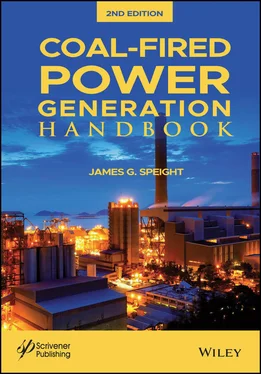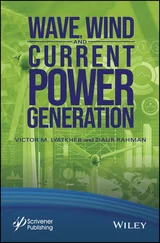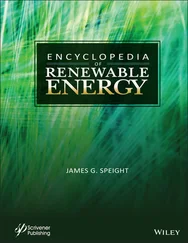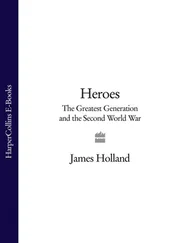Desulfurization by chemical techniques is somewhat less well developed than desulfurization by physical methods. However, a number of methods are under serious consideration and they can be divided into three general groups: (i) those which remove pyritic sulfur; (ii) those which remove organic sulfur; and (iii) those methods which remove either the pyritic sulfur or the organic sulfur or both (Couch, 1991; Ali et al ., 1992).
Therefore, effective desulfurization requires that three criteria should be satisfied: (i) the reagent must be highly selective to either pyritic or organic sulfur for both) and not significantly reactive with other coal components, (ii) the reagent must be regenerable so that once-through reagent cost is not a major factor, and (iii) the reagent should be either soluble or volatile in both its unreacted and reacted form so that it can be near totally recovered from the coal matrix.
The use of strong bases (alkali, caustic) appears to offer some solution to the problem of organic sulfur removal and this approach continues to be investigated (Chatterjee and Stock, 1991).
There are many occasions when coal is transported by rail, road, and water in its journey from mine to market. In some mining areas near the coast the coal was taken by conveyors directly from the mine to the holds of large coastal vessels. For example, in Britain, much of the coal from the northern coalfields is taken to the south in coastal cargo vessels called colliers. Large-scale haulage of coal by truck is normally economic only over relatively short distances.
There has, however, been the tendency during recent years to construct large industrial (chemical or power) plants close to the mine site in order to reduce coal-hauling costs and the coal is carried directly to the plant either by high-capacity truck on conveyor belts. In fact, the oil sand processing plants in northern Alberta employ this concept and transport the sand on several miles of conveyor belt to the processing plant (Speight, 1990).
It is easier (and more economical) to transport synthetic crude oil to market than to transport low-value oil sand. Similarly, it is much cheaper to transmit electricity over long distances by means of high-voltage wires than to move the equivalent tonnage of coal. However, the capital costs (and inconvenience) of constructing a plant in a remote area with a hostile environment near to a mine may dictate that this concept he impractical. Thus, the suggestion that coal be transported from the mine site completely or, in part, as a coal/water or coal/oil slurry in pipeline systems may have some merit and could afford a ready means of moving coal to markets using already existing pipeline system(s).
Generally speaking, the majority of mined coal is transported to market by railroad, the remainder being shipped or trucked to its destination or used at the mine. Shipping coal by rail has become a major industry in many parts of the world.
The unit train is the most common form of long-distance coal transportation. A unit train is a group of railcars that operate in a dedicated shuttle service between a coal mine and a power plant.
A typical unit train consists of 100 to 120 railcars and 3 to 5 locomotives, with each railcar holding approximately 100 to 110 tons of coal. Carefully coordinated loading and unloading terminals are necessary to minimize costs. A unit train making a round trip from mine to plant has a typical turnaround time of 72 hours, including a 4-hour loading and 10-hour unloading and servicing time per train.
The system is designed so that the trains can be loaded and unloaded without stopping the train, thereby providing a continuous means of shipping the coal as well as an increase in the rate at which the coal can be moved from the mine site to the consumer (Lindberg and Provorse, 1977). As a typical example, it is difficult to drive on many roads in eastern Wyoming, on any given day, without passing several such trains carrying coal to market. In fact, rail service is the lifeline of the large majority (95%) of the western coal mines.
Modern unloaders use rotary dump devices, which eliminate problems with coal freezing in bottom dump cars. The unloader includes a train positioner arm that pulls the entire train to position each car sequentially over a coal hopper. The dumper clamps an individual car against a platform that swivels the car upside down to dump the coal. Swiveling couplers enable the entire operation to occur while the cars are still coupled together. Unloading a unit train typically takes approximately three hours.
Shorter trains may use railcars with an air-dump , which relies on air pressure from the engine plus a hot shoe on each car. When the hot shoe comes into contact with a hot rail at the unloading trestle, it shoots an electric charge through the air dump apparatus and causes the doors on the bottom of the car to open, dumping the coal through the opening in the trestle. Unloading one of these trains takes anywhere from an hour to an hour and a half. Older unloaders may still use manually operated bottom-dump rail cars and a “shaker” attached to the cars to dump the coal.
The cost of shipping coal by train is often more than the mining costs. Using a barge or ship to move coal is a lot less expensive. In the United States there are 25,000 miles of waterways, but not enough to reach all destinations in the country. To reduce transportation costs, power plants are sometimes constructed near coal mines.
Barges on rivers and lakes play an important role in coal transport in the United States and Europe. Coal-carrying barges move in tows of fifteen to forty barges, pulled by a single towboat of 2,000 to 10,000 hp. A “jumbo”-size barge carries 1,800 tons of coal, so a large tow can move 72,000 tons of coal, as much as five unit trains. These large volumes result in significant economies of scale and lower costs. Barge rates can run (on a cost-per-mile or cost-per-kilometer basis) a quarter or less of rail rates. However, waterways often follow circuitous routes, resulting in slow delivery times.
Another method to transport coal is through a slurry pipeline. This connects a mine with a power plant where the coal is used to generate electricity. Coal slurry pipelines use a slurry of water and pulverized coal. For pipeline shipment, the coal is ground to approximately the size of coffee grounds and mixed with water to form the slurry. At the power plant the coal is either fed directly to the fuel preparation system or to a pond where the coal settles out and, at a later date, is re-slurried and then pumped to the fuel preparation system. The ratio of coal to water is approximately 1 to 1.
The coal removed from the mine is crushed to a diameter of around one millimeter, and is mixed with water in holding tanks with agitators, which keep the coal in suspension in the water. The pipeline consumes around a billion gallons of water annually. After three days the slurry reaches the end of the pipeline, at the Mohave power plant, where it is held in agitated tanks, for immediate use, and in drying ponds, for later use. Heated centrifuges are used to get the water out. As of 2006, the plant was shut down because the coal and water supply terms are being renegotiated.
Coal slurry pipelines are potentially the least costly available means for transporting coal to any location, measured in economic terms. Whether this is true with reference to any particular pipeline can only be determined by detailed evaluation of the conditions of the route. The current coal transportation scenario does not offer any choices between slurry pipelines and rail-road, which undoubtedly will necessarily minimize the cost of transporting coal. In this context the present times warrant assessment of the potential economic, environmental, and social implications of coal slurry pipeline development and transportation of coal through it.
Читать дальше












